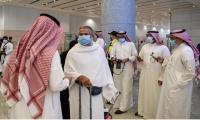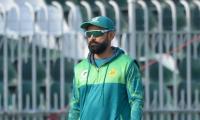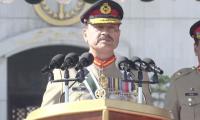Women leaders from across the globe were brought together at the 10th International Women Leaders’ Summit held in Karachi on Thursday to reflect on their stories of success and inspire others to take the lead.
A pioneer in leadership development for professional women, New World Concepts, led by Yasmin Hyder, has been organising the International summit in Karachi since 2012. The premier annual conference series has to date hosted 160 speakers from 40 countries and over 2,300 delegates in the previous nine conferences.
Yasmin highlighted that this conference was a culmination of a decade of achievements in women leadership and empowerment. Moderator Zainab Saeed asked an all-women panel at her session titled ‘Investing in Women in Growing World’ what the biggest obstacle was for the woman labour force participation.
European Union (EU) Ambassador to Pakistan Androulla Kaminara responded by mentioning stereotypes and lack of support. To the high commissioner of Canada, Wendy Gilmour, it was mobility and access to opportunities in Pakistani context. The operations manager at the World Bank Group Pakistan, Melinda Good, thought that at macro-level girls weren’t enrolled in skills; hence, they did not become part of the workforce. The CHRO at the National Bank of Pakistan (NBP), Asma Shaikh, said that the biggest challenge as a woman was to hear that certain roles were not for women or organizations were not ready to hire women as yet. Before joining the public sector NBP, which has a staff strength of over 20,000 people, Asma was also interviewed for some other very large public sector organisation, which she didn’t name. “I was the only woman among top five or six candidates,” she said.
She found out from the consultant that the MD, when he looked at her papers, asked his team why they had shortlisted a woman, because never had a woman been hired for that position. “The reason was that they were not ready for women in the public sector organisation,” she recalled and added that she still went into the interview room with the fact in her mind that she had to defend herself as a woman.
The interview, she said, went very well. “The same gentleman asked me what my biggest disadvantage is,” she said and remembered him saying that she looked very young. “We have to develop a very thick skin. The NBP took a very bold decision by hiring me as a woman as a head of HR.”
Asma has employed about 20,000 in the bank. According to her, there are social and cultural reasons for women for not being able to get to the top level. “For those who against all the odds reach that top level, acceptability is still an issue in our country,” she said.
When Kaminara started her career with the EU, there were very few women managers within the EU itself. She had been part of many movements and was looking after a lot of development work today when there are 30 per cent women mangers within the organisation. The major battle they won was to demand data, she said.
“Once you have the data, you could prove that for one service you would have 10 per cent women applying, but only one per cent getting jobs,” she said and added that there were also positions where all 10 per cent got the job.
With this data, she shared, they started naming and shaming those who did not give jobs to females. Gilmour agreed with Kaminara and said that it was about doing a gender-based analysis to determine the cause of drop-off women in middle and senior management positions. She joined Canadian Foreign Service in 1990 when there were about 25 percent women in her class and at this point of her carrier she said they had about 10 per cent of those women left.
Women have chosen t o step out because of their family responsibilities. At federal level in Canada, there is a requirement of gender-based analysis to be part of the decision-making for every major policy and its interesting picking up on energy and other sectors, where, she said, it is generally not possible to see gender equality.
There was a gender-based analysis on snow clearance during the winter in her constituency. It was determined that as a work force measure more women took public transport to get to work than men did. “More men drove,” she said. “All of the snow-clearing priorities were to clear the roads first and not necessarily the sidewalks, not necessarily access to train and bus platforms.”
Resultantly, more women were being late to work than their male counterparts. Then there was a policy change and now the snow-clearing priority goes to pedestrians, social mobility, access to public transport, which is also great for the environment to encourage public to use public transport. “But it was specifically through that gender lens that those issues were looked at,” she said.
Special assistant to prime minister Dr Sania Nishtar in her address said that the federal government’s Ehsaas Programme and other programmes had been initiated to provide assistance to the public. She shared that the government was also looking forward to initiating programme for the health welfare of public, which had already been designed.
She appreciated how despite threats polio workers had been affectively carrying out their exercise throughout the country. From Karachi to Khyber, the polio programme was very vital for the country, she said. Women, she said, were half of the population of Pakistan and making efforts for empowering themselves. Under the Kamyab Nojawan Programme, she said, the youth of this country would be benefited.
Head of Digital Pakistan Tania Aidrus, in a session titled ‘Digital Pakistan’, said that the concept of women in the workforce or women in jobs had changed. “I think the internet has allowed us to do that,” she said.
The MD DPC at the State Bank of Pakistan Lubna Malik, in the same session, said that the State Bank’s one of the major strategic objectives was to promote financial inclusion, not only in women, but in general. “Our banked population is still not that good. I think this is one of the major drivers for the State Bank,” she said and added that they have been encouraging banks to go into small towns and unbanked areas. Even if the State Bank has different governors over the years, the commitment to financial inclusion is very much an institutionalised objective.
Aidrus said that the talk of financial inclusion had been there for many years and the numbers had not moved ahead. “The fundamental point here is who are we holding accountable? First of all, what are the goals?” she said and asked if the State Bank governor was going to get fired in those five years if those numbers did not get met.
“We have a phenomenal new State Bank leadership and they really care about this,” she said and hoped now it would set very aggressive targets because we were so far behind.
Other guest speakers include President Bahrain International Federation of Business Shaikha Hind bint Salman AlKhalifa; HR Director Arcelik Turkey, Buket Celebioven; CEO ICI Pakistan Ltd, Asif Jooma; Pakistan Army’s Brigadier Nadia Hayat; CEO Standard Chartered Bank Pakistan Shazad Dada; Executive Director Pharma Bureau, Ayesha Tammy Haq; SEVP National Bank of Pakistan, Jamal Baquar; Pakistan Navy’s Commodore Gulnaz Ahmed; George Washington University USA’s Dr Nino Paichadze; and Pakistan Air Force’s Squadron Ldr. Ambreen Gul.
Shaikha Hind bint Salman AlKhalifa of Bahrain spoke about the role of women leaders in the Muslim world and the success of women in boardrooms in shaping organisational strategy and growth. Patchamuthu spoke how the new initiative of ‘Girls Learn, Women Earn -- 100 days of action’ was effective. He also underlined World Bank’s commitment to create more awareness about the importance of girls education and women’s participation in the workforce.
Commodore Gulnaz Ahmad, Brigadier Nadia Hayat and Squadron Leader Ambreen Gul shared their experience of performing their duties in the face of severe challenges.
The picture shows a pharmacy. — AFP/FileThe Karachi administration has launched a campaign to check the expiry dates...
In this still, Karachi Mayor Barrister Murtaza Wahab addresses an event on April 25, 2024. — Facebook/Barrister...
In this still, Sindh Inspector General of Police Ghulam Nabi Memon chairs a meeting at the Central Police Office on...
Representational image shows police tape. — AFP/FileAn elderly man who ran a general store was shot and killed in...
A handcuffed suspect stands behind the bars with a policeman standing outside the jail in this undated image. —...
In this still, Sindh Chief Minister Syed Murad Ali Shah meets federal energy minister Owais Ahmad Khan Laghari in...







